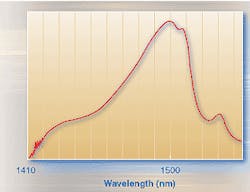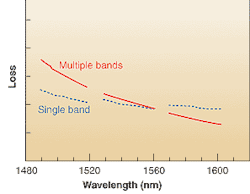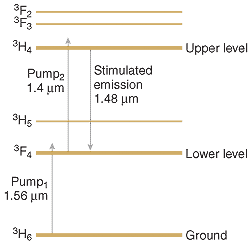
The next logical frontier for optical amplification is the S-band, which the International Telecommunications Union has defined as wavelengths from 1460 to 1530 nm. The S-band is adjacent to the standard erbium-fiber amplifier C-band at 1530 to 1565 nm, without the bend-sensitive losses that become significant beyond the 1625-nm end of the L-band. A few "hero experiments" have already used S-band amplification to transmit extremely high data rates through single fibers. Last year's record-setting demonstration of 10.92-Tbit/s transmission through a single fiber included 85 channels in the S-band.1
The collapse of the telecommunications bubble last year eased near-term demand for higher fiber transmission capacity, but progress on S-band amplifiers continues. Developers face some important technical challenges. As defined by the ITU, the S-band spans 70 nm, twice the 35-nm width of the C band in wavelength units (and more than double it in frequency units). It's likely that two types of amplifiers may be needed to span the entire S-band with reasonably uniform gain. Some developers informally recognize that possibility by splitting off the S+ band at 1450 to 1490 nm from an S-band shortened to 1490 to 1530 nm.
So far the leading approaches are Raman fiber amplifiers and thulium-doped fiber amplifiers, which can be combined to make hybrid amplifiers like those used to flatten gain profiles in the erbium-fiber band. A few other approaches are under development, including specially designed erbium-fiber amplifiers.
Raman-fiber amplifiers
A major attraction of Raman-fiber amplification is its inherent flexibility, because the gain is offset from the pump wavelength by an amount that depends on the fiber composition. In silica fibers, the Raman gain is spread over a range of frequencies peaking at 13 THz from the pump line (see Fig. 1). This makes Raman gain available across the entire transmission spectrum of the fiber as long as suitable pump sources are available. Pumping at 1410 nm, for example, produces peak Raman gain at 1500 nm.
Pumping at multiple wavelengths can smooth the Raman gain curve across a wider range of wavelengths. Pumps are typically spaced every 20 to 30 nm, depending on the gain uniformity required. With suitable pump sources, a single amplifier can span a wavelength range of more than 100 nm, from the S-band into the L-band.2
Discrete Raman amplifiers use lengths of fiber packaged as discrete units, rather than as part of the transmission line. They often use dispersion-compensating fiber, which has a very small core, so its Raman gain is 5 to 10 times higher than standard step-index single-mode fiber. Pump lasers are mounted on one or both ends of the discrete amplifying fiber. An amplifier that uses compensating fiber also can provide dispersion compensation for a span of the fiber transmission line. Typical discrete Raman amplifiers contain several kilometers of fiber.
Alternatively, the transmission fiber can serve as a distributed Raman amplifier, an approach widely used for hybrid Raman amplification in the C- and L-bands. Typically, the pump laser is on the receiving end of the fiber, so it transfers power to signals that have been weakened by attenuation in the transmission span. This produces lower peak powers at signal wavelengths than pumping in the same direction as the signal is traveling, reducing nonlinear effects. It also produces lower noise levels than discrete Raman amplifiers.3Rayleigh scattering makes attenuation in the S-band about 6% higher than in the C-band, so a little more amplification is needed to span the same distance. More important, the pump wavelengths needed for S-band Raman amplifiers can experience much higher attenuation because they fall within the broad water-absorption band centered at 1383 nm. The higher the water absorption, the more pump power is needed to produce the desired amount of gain (an effect that reduces the effective length of the amplifier). By concentrating amplification in a shorter length of fiber, this also increases noise levels.
Fiberoptic systems transmitting in the C- and L-bands as well as the S-band experience interband Raman scattering, because signals in the S-band can serve as pumps for wavelengths in the C- and L-bands. This transfers power from the S-band signals to the longer-wavelength signals, mostly to the L-band (see Fig. 2). The overall effect is to increase loss in the S-band while decreasing loss in the L-band. In addition, this can generate noise by adding a fraction of the shorter-wavelength signal to the longer-wavelength signal.
The Raman gain profile of silica peaks strongly at longer wavelengths, but other materials have different Raman spectra. This makes it possible to equalize gain across a wider spectral range by adding Raman gain stages made from materials other than silica glass. One interesting example is a hybrid consisting of a 250-m length of tellurite-glass fiber, a 10-km length of conventional dispersion-compensating silica fiber, and a 200-m length of tellurite fiber. Careful selection of pump wavelengths matched the peaks of the tellurite gain to low points in the silica gain curve, with gain of at least 20 dB from 1492 to 1633 nm, a total of 141 nm.4Thulium-doped fiber amplifiers
The main alternative to Raman amplification for the S-band is the thulium-doped fiber amplifier. As in erbium-doped fiber amplifiers, the gain comes from stimulated emission by rare-earth ions doped into a fiber core. However, the energy-level structure of thulium leads to many important differences between thulium and erbium amplifiers in addition to their wavelengths. Thulium produces stimulated emission on a transition above the ground state, but in erbium the lower level of the amplifying transition is the ground state (see Fig. 3). This makes thulium inherently less efficient, so optimizing the pump source is particularly important. Thulium's properties also make silica glass a poorer host than other materials, so most thulium amplifiers use fluoride-glass fibers, although other types have been tested, including tellurite glass.The best-developed thulium amplifiers have peak gain near 1470 nm, and strong enough gain for practical use in a 30-nm range between about 1455 and 1485 nm, sometimes called the S+ band (see Fig. 4). They usually are pumped with a diode-pumped ytterbium-fiber laser emitting near 1050 nm. Commercial thulium-doped fibers have small signal gain around 25 decibels, and noise figure below 7 dB. The gain of these devices drops at longer wavelengths, functionally leaving open the longer-wavelength half of the S-band, from 1485 to 1530 nm, where fiber attenuation is lower.
One approach to filling that gap is heavily doping the fiber core, so it contains around 6000 parts per million of thulium. The high density of thulium atoms allows interactions between them, which changes transition probabilities and makes it possible to produce the low population inversion needed to shift the gain band to longer wavelengths. Laboratory experiments have used this approach to shift thulium amplifier gain to 1480 to 1510 nm while still pumping with a single diode-pumped ytterbium-fiber laser near 1050 nm. However, gain remains limited.
Another way to shift gain to longer S-band wavelengths and increase efficiency is by dual-wavelength pumping. This works because thulium must be pumped two steps up the energy-level ladder, as shown in Fig. 3. The idea is to increase pump absorption by matching one pump wavelength to the transition from the ground state, and the second to the transition from the lower laser level. Several combinations are being evaluated, including 1556 and 1238 nm, 1238 and 1400 nm, and 785 and 1400 nm, with the latter using the readily available 785-nm line to pump directly from the ground state to the upper level.5
S-band erbium amplifiers
Erbium-doped fibers have gain at wavelengths shorter than 1530 nm, but amplification is difficult to obtain because it requires a high level of population inversion, which usually causes strong amplified spontaneous emission. However, strong suppression of amplified spontaneous emission, by introducing high attenuation at 1530 nm, allows net amplification when pumping at 980 nm.
In one demonstration, the erbium-doped fiber was divided into five stages, each 4.5 m long, separated by filters with 30-dB absorption at 1530 nm and pumped at both ends by 980-nm sources. Addition of a discrete Raman amplifier using dispersion-compensating fiber produced uniform gain between 1489 and 1519 nm.6 Recent experiments reported gain from 1480 to nearly 1530 nm, with peak gain of 34 dB, using only an erbium-fiber amplifier with strong filtering of 1530 nm to block amplified spontaneous emission.7
Outlook
Semiconductor optical amplifiers can be made for the S-band, but their application in wavelength-division multiplexed systems has been limited by high crosstalk between optical channels. If new designs can reduce that crosstalk, they might find applications in wavelength-division-multiplexing systems that require few amplifiers, such as metro networks.8
Several issues remain before S-band amplifiers are ready for widespread use. One is the potential overlap between Raman pump sources for the L- and C-band and signal wavelengths in the S-band. Another is effective gain equalization over wide bands, including Raman interactions among wavelengths. Guard bands may be needed to separate blocks of optical channels. Interactions among optical channels and noise levels need to be examined. Yet the most important issue is likely to be economic. Will it be cost-effective to add dozens of optical channels in the S-band to fibers already carrying signals in the C- and L-bands?
REFERENCES
1. K. Fukuchi et al, OFC 2001, Postdeadline paper PD-24.
2. T. Miyomoto, et al, OFC 2002, paper TuJ7.
3. J. Bromage et al, OFC 2002 paper TuB3.
4. H. Masuda et al, OFC 2002, paper ThB6.
5. F. Roy, OFC 2002, paper ThZ1.
6. E. Ishikawa et al, ECOC 2001, Postdeadline Paper PD.A.1.3.
7. J. D. Kmetec, Lightwave Electronics Corp.
8. J. B. Khurgin et al, EEEE Phot. Tech. Lett. 14, 278 (March 2002).
About the Author
Jeff Hecht
Contributing Editor
Jeff Hecht is a regular contributing editor to Laser Focus World and has been covering the laser industry for 35 years. A prolific book author, Jeff's published works include “Understanding Fiber Optics,” “Understanding Lasers,” “The Laser Guidebook,” and “Beam Weapons: The Next Arms Race.” He also has written books on the histories of lasers and fiber optics, including “City of Light: The Story of Fiber Optics,” and “Beam: The Race to Make the Laser.” Find out more at jeffhecht.com.



